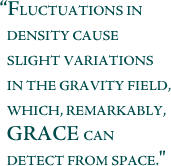

Gravity 101 We can think of gravity as the invisible force that pulls two masses
together. When we speak of mass, we’re talking about the amount
of matter in a substance. Density is a measure of how much mass is concentrated
in a given space. Sir Isaac Newton discovered that as an object’s
mass increases, the gravitational attraction of that object increases.
For example, a container filled with a more dense material like granite
rock has more mass and thus more gravitational attraction than that
same container filled with water. The Earth’s Moon has considerably
less mass than the Earth itself. Not only is the Moon smaller than the
Earth, but it is only about 60 percent as dense as Earth. Thus, the gravitational
attraction on the Moon is much less than it is here on Earth, and a person
weighs less on the Moon. This weaker gravity is why we have the famous
images of the Apollo astronauts taking “one giant leap for mankind” on
the Moon’s surface. |

GRACE |
||
|
On planet Earth, we tend to think of the gravitational effect as being the same no matter where we are on the planet. We certainly don’t see variations anywhere near as dramatic as those between the Earth and the Moon. But the truth is, the Earth’s topography is highly variable with mountains, valleys, plains, and deep ocean trenches. As a consequence of this variable topography, the density of Earth’s surface varies. These fluctuations in density cause slight variations in the gravity field, which, remarkably, GRACE can detect from space. A Closer Look at the Gravity Field Although the Earth’s surface is not uniform, for the most part, the variations are constant over very long time intervals. In other words, if a mountain was at a given location last month, it’s probably going to be at that same location this month as well, and for all intents and purposes the mass of the mountain is unchanged. This means that the gravity influence of these larger features is pretty much the same over a very long time and is known as the mean (or long-term average) gravity field. There are other mass variations, however, that occur on much smaller time scales. These are mostly due to variations in water content as it cycles between the atmosphere, oceans, continents, glaciers, and polar ice caps. These shorter-term mass fluctuations contribute to what is known as the time-variable gravity field. Both the mean gravity field and the monthly maps of the time-variable gravity field are useful tools for scientists as they study the Earth’s changing climate. The mean gravity field helps scientists better understand the structure of the solid Earth and learn about ocean circulation. Likewise, scientists use time-variable gravity to study ground water fluctuations, sea ice, sea level rise, deep ocean currents, ocean bottom pressure, and ocean heat flux. next: Gravity
Anomaly Maps and The Geoid |
This famous photograph of an astronaut taking a “giant leap for mankind” demonstrates the effect of the moon’s lower gravity on a person’s weight. Because the moon is smaller than the Earth and about 60 percent as dense, the astronaut’s weight is only about one-sixth of what it would be on Earth. Although they are not as dramatic as the Earth-moon difference, slight variations in the mass and density across the Earth’s surface do create differences in Earth’s gravity field. |